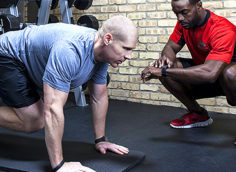Personal training is a rapidly growing industry, and for good reason. There aren't many careers where you can channel a passion for fitness into a potentially lucrative enterprise and experience the satisfaction of helping others achieve their fitness goals along the way!
But if you're one of the many gym rats considering making personal training your full-time career, you need to be aware of the education options available to help you reach your goal. Generally, there are three primary routes you can take, each with its own set of pros and cons to consider.

Option 1 – Get a Degree in the Field
From an academic point of view, you simply can't knock the education you'll receive from obtaining a degree in kinesiology/exercise science or a related field. This career path will certainly go into the most detail about the "how's and why's" of the body and its response to exercise.
But while I never discourage someone from enhancing their education, this road does have some negatives to consider. First, it's certainly the most expensive and most time consuming option, as a degree will cost at least $40,000 (and often much more than that), and can easily take three to four years to complete. Often, once someone is older and somewhat established in life (such as when becoming a trainer is a second career), three to four years of full time school simply isn't feasible.
Further, although a professional degree usually does a good job of explaining how the body works, many degreed programs are often significantly lacking in the practical aspect of personal training and fitness education. Once someone has a degree, many fitness companies will still often want him or her to acquire an additional personal training certification. So as comprehensive as a professional degree may be, it may still not be enough.
Finally, currently the difference in pay rate for a personal trainer with a degree and without is not that significant. In short, acquiring a professional degree in the field may be helpful for aspiring trainers, but it's not a necessity.
Option 2 – Get Certified
The most popular route to becoming a personal trainer is to get certified. Most recognized certifications last two to four years (before they expire) and are essentially prepared for in three stages:
- Order the study material and study on your own (usually a textbook and/or DVD's with online help available). This usually takes anywhere from one to six months to complete, but it's at your own pace. Total cost of materials is usually $300-$400.
- Sign up for a weekend review course (usually two full days, 16 hours total). Ballpark cost of the test review is usually around $250.
- Sign up for and take the exam. Normally you need to be CPR/First Aid/AED certified to sit for the exam. Average cost of taking the exam is around $250.
There are many benefits for going this route.
- It's the cheapest option, usually totaling under $1000.
- The starting rate of pay for a certified trainer is similar to that of a new trainer with a degree or diploma.
- You can study at your own pace, so it can fit a variety of lifestyles/work schedules.
- Finally, given the variety of certifications available, you can pick an organization that most closely matches your own fitness philosophy.
However, most certifications do have limitations.
- Often the amount of actual time of education under an instructor is very low.
- There's minimal time spent in the actual gym, and someone could easily pass a certification exam and still be very lacking in both the academic and practical knowledge necessary to be a successful personal trainer.
- Certifications have additional fees long past your graduation date. All certifications expire in two to four years and require the member to take CEU's (continuing education units) which are mandatory to maintain good standing. Those CEU's cost money.
Certification Options
There are many different certification organizations available. Not surprisingly, some are very reputable and others not so much. (If you're taking the exam on your home computer and then printing out your own certificate, that's a bad sign.)
Generally, you want to look for organizations that are certified by the Institute for Credentialing Excellence (ICE), which recently changed its name from the National Organization for Competency Assurance - NOCA. Listed below are the top five options for getting certified as a personal trainer, with pros and cons for each.
NSCA – National Strength and Conditioning Association.
Two certifications available:
- CPT – Certified Personal Trainer. A college degree isn't necessary to take this exam.
- CSCS – Certified Strength and Conditioning Specialist. You need a college degree to sit for this exam. This is a popular choice for those working with athletes.
Pros:
- The NSCA is well established and widely accepted.
- They're more focused on performance instead of "pure health."
- The CSCS is the most popular choice for strength coaches.
Cons:
- There's little focus on anatomy or nutrition with the NSCA.
ACSM – American College of Sports Medicine.
Two certifications available:
- CPT – Certified Personal Trainer
- HFS – Health Fitness Specialist. This is their more advanced certification, better for special populations. You need an associate's degree to sit for this.
Pros:
- The ACSM is more focused on health than performance. They set the standards for risk factors, health assessments, and training beginners.
- The ACSM also offers clinical exercise and specialty certifications. This is a good certification to get if you want to work in hospitals or with people with disabilities.
Cons:
- The ACSM seems to be fading in popularity with gyms and fitness centers, likely due to their focus on improving health as opposed to improving performance.
NASM – National Academy of Sports Medicine.
Three certifications available:
- CPT – Certified Personal Trainer. Their basic certification.
- PES – Performance Exercise Specialist. Designed for training athletes, need NASM-CPT or a college degree to take this exam.
- CES – Corrective Exercise Specialist. Designed for dealing with injuries.
Pros:
- The NASM goes into reasonable detail on the kinematic chain, postural assessments, and relies heavily on functional training.
- It has very specific exercise design protocols. It's well accepted, sometimes preferred, by most fitness organizations and it seems to be increasing in popularity.
Cons:
- This is the most polarizing certification (some people love it, some people hate it).
- Postural assessments can be very tricky to do properly and may be outside the scope of a personal trainer.
- Although this is my opinion, I would be remiss if I didn't mention that I believe their suggested exercise program design protocols don't provide optimal results when it comes to training for increased strength, size, or performance.
ACE – American Council on Exercise.
Four certifications available:
- CPT – Certified Personal Trainer. Basic Certification
- Advanced Health and Fitness Specialist Certification. Designed for dealing with special populations, need to be a CPT or have a degree to sit for this exam.
- Group Exercise Instructor. For teaching aerobics classes.
- Lifestyle and Weight Management Consultant. Certification designed to help clients lose weight, must be a CPT to sit for the exam.
Pros:
- Widely accepted, been around for a while, decent textbook.
Cons:
- Considered kind of basic, test has "trick" questions with multiple right answers and doesn't focus much on anatomy, exercises, or program design.
TW-CC – Training and Wellness Certification Commission
One certification available:
- A-CPT – Advanced Certified Personal Trainer
Pros:
- Must have a college degree in a related field AND 200 hours of practical experience, OR have completed a 500-hour long state approved program in personal training.
- Has the hardest of the personal training exams (in my opinion).
Cons:
- Newest of the main certifications, name may not be as recognized as the other certifications; still just a single test to become certified.
I helped create the A-CPT exam (along with many others) and I believe that it does the best job of assessing what knowledge a trainer really needs to know to be successful. That doesn't mean the test is perfect or couldn't be better, but it does heavily stress practical information such as what muscles are working during certain exercises, exercise program design, anatomy, physiology, and nutrition.
Interestingly, within the next five to ten years it will likely be legislated that all trainers meet education requirements similar to that of the A-CPT before receiving a personal trainer certification.
Option 3 – Get a Diploma
The negative aspect of all certification courses is that they are primarily self-study, and the level of education now expected of personal trainers is difficult to derive from a textbook. But going to college is great but impractical for some, so a third option is get to get a diploma in personal training.
To do this, a student will attend a 500-hour long, state approved program to teach personal training. Upon graduation, you'll receive a diploma in personal training which grants the title of "Certified Personal Trainer," but because it's a diploma, it doesn't expire. Currently, there's one main organization that offers this option, and this is the company that I work for.
NPTI – National Personal Training Institute
Three certifications upon completion
- CPT – Certified Personal Trainer
- Certified in Basic Nutrition
- Certified in CPR/First Aid/AED
Pros:
- NPTI is an actual school, so the students can learn from and can ask questions of instructors.
- There are over 650 test questions students will be tested on. Students will spend 300 hours in the classroom and receive 200 hours of practical experience in the gym.
- Classes are held during the day, evening, or weekends to fit a person's schedule.
- NPTI is approved by the Department of Education in all states that it operates in, and the program is available for the GI Bill, Military Spousal Support (MyCAA), Unemployment compensation, and Pell Grants are pending.
Cons:
- NPTI is much more of a time commitment than the normal certification; it will take 6-12 months to get certified.
- NPTI is more expensive than the other certifications, with the total cost being $6,300, although textbooks and a gym membership are included in the price.
- NPTI has an attendance policy and any class time missed must be made up.
- NPTI is newer than the other big fitness organizations (created in 2001) so it may not be as well recognized as the other certifications.
- Students must attend a specific class with a specific instructor so they can't study on their own or at their own pace.
- Like most classes or college courses, the instructor can make or break the class.
Wrapping It Up
Those are your educational options for becoming a personal trainer. Before you pull out your credit card and spend your hard-earned cash on what will essentially be your professional credibility, do some research and pick the one that is right for you.
If you're already spending all day in the gym, why not get paid for it? If you're ready to help others see and feel the power of fitness first-hand, becoming a personal trainer just may be the right path for you.




